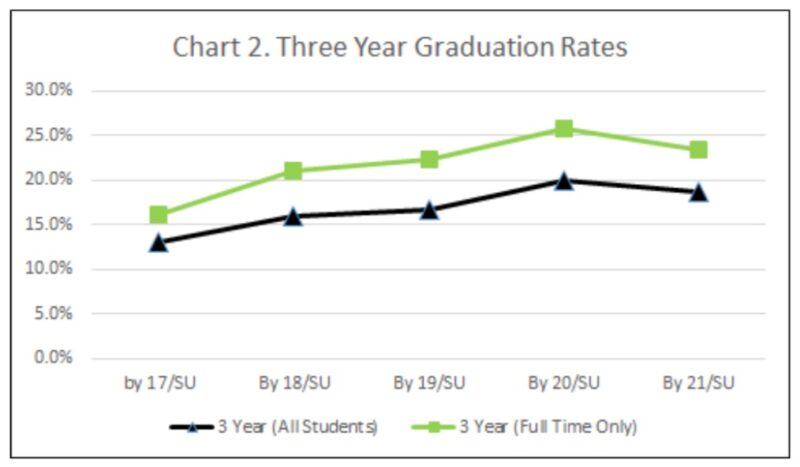Completion Plan for 2022-2024 describes past achievements and future approaches to improving student success

Cincinnati State’s Student Success and Completion Plan for 2022-2024 has been approved by the Board of Trustees and submitted to the Ohio Department of Higher Education (ODHE).
All public colleges and universities in Ohio are required to submit a Completion Plan every two years. This requirement started in 2014 in response to action by the Ohio legislature.
According to ODHE, Completion Plans are intended to “provide a continuous improvement framework that can allow campuses to identify and implement strategies to increase the number and percentage of students earning meaningful postsecondary credentials.”
Provost Robbin Hoopes, who presented the plan to the Trustees for approval at their June 28 meeting, noted several achievements described in the most recent Cincinnati State Completion Plan, including:
- An increase in the percentage of Career Tech high school students who become Cincinnati State students. “The scale of the increase in high school Career Tech students coming to us is not enormous, but the percentage increase– more than 200 percent– is incredible,” Provost Hoopes said.
Provost Hoopes said these improvements are a result of efforts by Rita Graf (Chief Administrator, Southwest Ohio Tech Prep), Gretchen Cook (Manager, Perkins Pathway and Transition Project) and others who are collaborating to provide outreach and support to high school Career Tech students, and encouraging students to apply their high school credits to technical degree programs at the College.
- Improvements (despite pandemic challenges) in key measures such as increased rates of graduation within three years of entering the College (see chart above) and increases in numbers of degrees and certificates awarded. Provost Hoopes said the College is also showing improvements in other important measures of student success like course pass rates, total credit hours earned, and persistence rates (how many students enrolled in Fall continue in Spring).
“The overall goal is to reduce the time it takes for a student to complete their degree, and the key indicators show we are moving in the right direction,” Provost Hoopes said.
- Significant positive results from the “multiple measures” advising strategy (that does not rely on placement test scores) and from replacing developmental education courses with college-level English and Math classes that provide extra support for students. “Taken together, these changes have increased completion of college-level English Composition during a student’s first semester from 43 percent to 61 percent, and increased completion of a college-level Math course in the first semester from 32 percent to 51 percent,” Provost Hoopes said.
- Benefits from the online New Student Orientation program, which was implemented just prior to the pandemic-related move to remote operations. “When we offered traditional in-person orientation, participation was less than 10 percent,” Provost Hoopes said. “Now, 70% of new students complete some or all of the online New Student Orientation.”
Provost Hoopes said that initiatives currently underway should help the College in reaching student success goals during the next two years. These efforts include:
- Adding full-time Advisors for each academic division, who serve as “thought leaders and coordinators” for advising activities. To promote College-wide coordination and teamwork for processes that are part of new student onboarding, the Provost’s Office is leading weekly meetings that bring together the full-time Advisors and representatives of Admissions, Financial Aid, the Registrar’s Office, and Disability Services.
- Completing the IT/Colleague modernization project, which will provide efficiencies for students and for the College offices that assist new students. The Colleague improvements also will make it possible to implement online Degree Maps, an important tool for students so they can track their academic requirements and their progress toward their goal.
- Providing ongoing support for faculty professional development, with focus on improving course design and teaching skills for both online and in-person courses, through the work of the Center for Teaching and Learning, the Office of Online Learning, and other assistance initiatives.